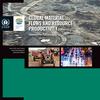Похожие презентации:
Lithium project
1.
MINISTRY OF HIGHER EDUCATION,SCIENCE AND INNOVATION
YANGIYER BRANCH OF TASHKENT INSTITUTE OF
CHEMICAL TECHNOLOGY
LITHIUM AND ITS COMPOUNDS: NATURAL
RESOURCES, PROCESSING AND APPLICATION
2.
RELEVANCEThe development of electronic devices and
electric cars is leading to an increase in the demand for
lithium. lithium is called an energy metal and the oil of
the 21st century.
This circular chart shows the major global uses of lithium as of
2022. The largest use was for batteries (80%); followed by
ceramics and glass (7%); lubricating greases (4%); continuous
casting fluxes (2%); and others (7%).
3.
World mine production of lithium, 2013–2022 (p)Australia is the global leader in lithium production, with five mines
accounting for nearly half of the lithium production in 2022. Brine
operations in Chile and Argentina and mines in China accounted for
most of the remaining forecasted production in 2022. China is the
global leader in lithium processing, with most of the processed
products being used in battery production.
Ranking
1
2
3
4
5
6
7
8
World total
Country
Australia
Chile
China
Argentina
Brazil
Zimbabwe
Portugal
Canada
Tonnes
61,000
39,000
19,000
6,200
2,200
800
600
500
129,300
Percentage of the total
47.2%
30.2%
14.7%
4.8%
1.7%
0.6%
0.5%
0.4%
100.0%
This bar graph shows the world’s annual mine production of lithium from 2013
to 2022. Lithium production was 34,000 tonnes in 2013 and stayed relatively steady
until 2015 when it was 31,500 tonnes. After surging demand for lithium batteries to
support the growing market for electronics, electric vehicles, and renewable energy
storage, mine production increased in 2016 to 38,000 tonnes. Mine production
increased significantly to 69,000 tonnes in 2017 and to 95,000 tonnes in 2018.
The prices recovered in 2021, as did lithium demand, driving up production to
a record high of over 104,000 tonnes. Excluding U.S. production, worldwide lithium
production in 2022 increased by 21% to approximately 130,000 tons from 107,000
tons in 2021 in response to strong demand from the lithium-ion battery market and
increased prices of lithium.
4.
Resources of lithiumPrimary resources
Minerals,
clays
Brines
Secondary
resources
5.
PRIMARY RESOURCES — MINERALS/CLAYSVarious lithium ores and their lithium content
Ore
Spodumene
Petalite
Amblygonite
Lepidolite
Eucryptite
Spodumene from Shovvozsoy
Chemical formula
LiAlSi2O6
LiAlSi4O10
(Li,Na)AlPO4(F,OH)
K(Li,Al)3(Si,Al)4O10(F,OH)2
LiAlSiO4
Li contained (wt%)
3.73
2.09
3.44
3.58
5.51
6.
PRIMARY RESOURCES — BRINES7.
SECONDARY RESOURCES — LITHIUM ION BATTERIESSources, quantity and collection of discarded lithium-ion batteries
8.
Secondary resources — lithium ion batteries9.
Waste lithium-ion batteries can be pre-treatedand separated safely only when they are fully
discharged. If not, the battery can explode or
emit toxic gases due to local short-circuiting.
The most used method is to submerge the
battery in a conductive solution, such as a NaCl
solution.
Methods to separate the active material from
the disposed battery can be broadly categorized
as mechanical separation, solution treatment
separation,
and
calcination
treatment
separation












 Промышленность
Промышленность








